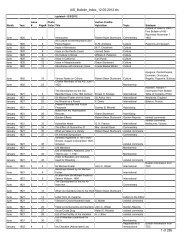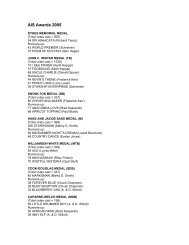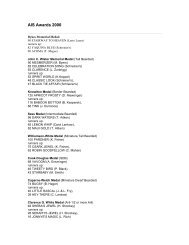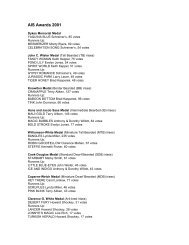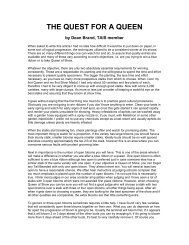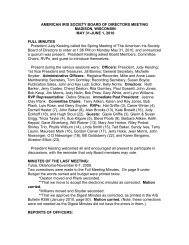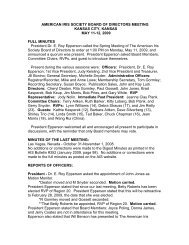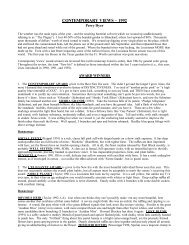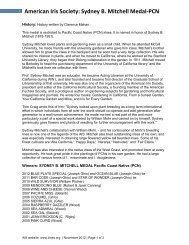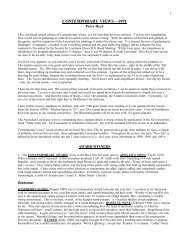contemporary views – 1988 award winners - American Iris Society
contemporary views – 1988 award winners - American Iris Society
contemporary views – 1988 award winners - American Iris Society
Create successful ePaper yourself
Turn your PDF publications into a flip-book with our unique Google optimized e-Paper software.
3. The 9-1-1 AWARD, given to the New <strong>Iris</strong> that is the most significant hybridizing achievement or color break. 9-1-1<br />
is the number you call when you think you’re gonna have The Big One. Recipients of this <strong>award</strong> leave you feeling that<br />
way, or least just a bit stunned! NEW WAVE (Hager 1986, MTB). Anyone who knows the background of this iris will<br />
realize the significance of the breakthrough. Tetraploid MTBs are still rare, and progress in this area has been slow and<br />
tedious. ‘New Wave’ is a pure white with broad form, yet still retains the grace that the class mandates. Slender stalks<br />
are flexuous but strong enough to support up to 4 branches and rebranch, often opening 3 to 4 flowers simultaneously.<br />
Notably vigorous (tetraploid MTBs have sometimes been deficient in this area), with an increase/bloom ratio that makes an<br />
outstanding clump.<br />
Runnersup: MAGIC (Hager 1987); GLITZ ‘N’ GLITTER (Black <strong>1988</strong>); LATIN HIDEAWAY (Nichols 1986).<br />
4. The SUN BELT AWARD, given to the Best Proven Variety (i.e., one that has been on the market at least 4 years;<br />
this year’s winner had to have been released prior to 1986): DARKSIDE (Schreiner 1985). A great, quality complement<br />
to the Contemporary Award winner, ‘Silverado’, this is the ultimate in a very advanced line of Schreiner irises that<br />
consistently have choice progeny. Even in the Blanchard garden, where Miss Kitty had salvaged what was left of the June<br />
flood last year and replanted as late as November, ‘Darkside’ produced tall, well branched stalks this spring. Broad,<br />
blocky flowers are purest deep violet (approaching black) with light to moderate ruffling and a silk sheen. The overall form<br />
is even better than the very fine ‘Titan’s Glory’ (Schreiner) or ‘Dusky Challenger’ (Schreiner). Exceptionally vigorous, a<br />
consistent bloomer (obviously, if it bloomed in Blanchard this year!), and strong, telephone pole stalks that will not fall<br />
over in Okie winds, even with 3 or 4 of its large blossoms open. It makes for a good garden iris in the clump, too, as the<br />
3 to 4 branches are modified candelabra. What is most impressive is that, even though the flowers are huge, it has backup<br />
buds that open in a proportionate size and with good bloom sequence.<br />
Runnersup: HELLCAT (Aitken 1983, IB); WARRIOR KING (Schreiner 1985); NAVAJO JEWEL (Weiler 1984).<br />
5. The DARK HORSE AWARD, given to the variety introduced within the past 10 years, that I feel has been<br />
overlooked by AIS judges, and deserves/deserved much higher praise in the <strong>award</strong>s system: HOLY NIGHT (K. Mohr<br />
1983). Although it finally won a fairly respectable HM last year, this consistent performer is worthy of an AM or maybe<br />
more. It has the height (up to 48”!), vigor, and width its parent, ‘Dusky Dancer’ (Luihn), never had, yet it retained the<br />
richness of lustrous sheen. Even last year, with all the freeze damage, it stood tall and stately with 4 branches on stalks<br />
strong enough to withstand the worst gales. The bloom sequence is especially meritorious, opening with consistency to<br />
achieve a long season of bloom.<br />
Runnersup: HEAVEN HELPED (Waltermire 1979); E.C. EVERINGHAM (Raabe 1980, LA); CLEARFIRE<br />
(Stevens 1981).<br />
6. The CREAM OF THE CROP AWARDS go to the 5 varieties on the Dykes Medal eligibility list that I consider<br />
most worthy, in order of preference. This means you’ll know what I support for the Dykes each year! [NOTE: This<br />
<strong>award</strong> category was discontinued in later editions of ‘Contemporary Views’]. PINK BUBBLES (Hager 1980, BB) is one<br />
of the best, more consistent BBs I have ever grown. I’ve seen it grow out of class only in those fanatical gardens where the<br />
soil is about 50% cow manure! (Meow!) An elegant clear pink with moderate ruffling and lace that even exceeds it worthy<br />
sister, ‘Beverly Sills’ (Hager, TB) in grace and charm. TITAN’S GLORY (Schreiner 1981), the first of many recent<br />
famous creations in this bloodline. It nonetheless holds its own for overall quality and dependability. ANN<br />
CHOWNING (Chowning 1977, LA) is still competitive today in the midst of many fine progeny in a very good<br />
Louisiana year. The richness of the red is beyond intense, and the large bright yellow signals are stunning. BRANDY<br />
(McWhirter 1981), so fine and finished, and with a color that cannot be mistaken for any other variety. Its form, plant<br />
habits, and branching are notable, especially being a color break. Its potential as a parent hasn’t even been tapped yet!<br />
And CLARA GOULA (Arny 1978, LA), the most elegant of all Louisianas, having an impact on the whole species that<br />
‘Snow Flurry’ (Rees) had on Tall Beardeds. It initially had the reputation for being a slow grower with weak vigor. This<br />
simply has not been the case at Bayou North (the Contemporary Gardens Louisiana patch). It does not have the Johnson<br />
grass vigor of ‘Red Echo’ (Rowlan) or ‘Black Gamecock’ (Chowning), but the plant habits and vigor are quite acceptable.<br />
7. The PICK OF THE LITTER AWARD goes to the most outstanding seedling viewed this year. The winner by a<br />
landslide is Black 8544B. Remindful of ‘Brandy’ (McWhirter), in that it is totally unique in color, yet backed up with<br />
the branching, bud count, bloom sequence, vigor, plant habits, forms, and finish that all must merge to produce a quality<br />
iris worthy of release into a market that, frankly, is flooded annually with poor or, worse yet, more-of-the-same varieties.<br />
The color is even more difficult to describe. It would be interesting to see if there is an RHS color chart on it. At least<br />
with ‘Brandy’ you can say, ‘Think of the drink”. 8544B is a smoky (but not dirty) light to medium raspberry with<br />
absolutely smooth hafts. Some are calling the color “mauve”. Beards are henna to coral. My personal favorite of all of<br />
2



